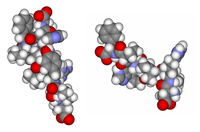
Photo from wikipedia
Peer et al in a previous issue of Angiology assess the value of various biomarkers in the development of left ventricular hypertrophy (LVH) in a hypertensive nondiabetic cohort. Despite limitations,… Click to show full abstract
Peer et al in a previous issue of Angiology assess the value of various biomarkers in the development of left ventricular hypertrophy (LVH) in a hypertensive nondiabetic cohort. Despite limitations, such as the small sample size and cross-sectional design, they concluded that adiponectin and aldosterone, in particular aldosterone to renin ratio, were independent predictors of LVH. Adiponectin is a white adipose tissue-derived 30-kDa protein that exerts insulin-sensitizing, anti-inflammatory, and antiatherosclerotic properties. It is downregulated in obesity (including metabolic syndrome [MetS], type 2 diabetes mellitus [T2DM], and fatty liver disease] and its levels have been inversely associated with high-density lipoprotein cholesterol and homeostatic model assessment insulin resistance (HOMA-IR) index. It has also been recognized as an independent cardiovascular disease risk factor. Adiponectin levels seem to be decreased in patients with coronary heart disease and stroke although adiponectin gene polymorphisms may also contribute to this relationship. Aldosterone mainly regulates sodium excretion by acting on its mineralocorticoid receptor (MR) at the distal nephron. It is secreted by the adrenal zona glomeruloza under the stimulation of angiotensin II (AT-II), potassium, and adrenocorticotropic hormone (ACTH). However, MRs have been identified in other tissues, such as heart (cardiomyocytes) and vasculature, including both endothelial and vascular smooth muscle cells (VSMCs). Except for acting on gene expression, some nongenomic effects have also been described for aldosterone, both on VSMC and endothelial cells, as well as on the heart, explaining in part the aldosterone-induced vasoconstriction via a rapid increase in intracellular calcium and Naþ–Kþ–2Cl cotransporter activity, respectively. Aldosterone excess has been associated with endothelial damage and cardiovascular injury, including inflammation, oxidative stress, cardiac hypertrophy, and fibrosis, mainly through its MRs, apart from sodium retention and hypertension. It also increases angiotensinconverting enzyme (ACE) and angiotensin I receptor messenger RNA (mRNA) expression in the heart and vasculature. Furthermore, increased aldosterone concentrations have been associated with the development of MetS and T2DM. Aldosterone decreases glucose-stimulated insulin release and insulin receptor expression in adipocytes and monocytes in an MR-dependent way. Primary aldosteronism (PA) is associated with decreased insulin sensitivity compared with essential hypertension, which seems to improve after surgical treatment. Interestingly, patients with PA have increased cardiovascular morbidity compared with ageand sexmatched controls with essential hypertension, indicating the multifocal role of aldosterone in the cardiovascular system.
Journal Title: Angiology
Year Published: 2018
Link to full text (if available)
Share on Social Media: Sign Up to like & get
recommendations!